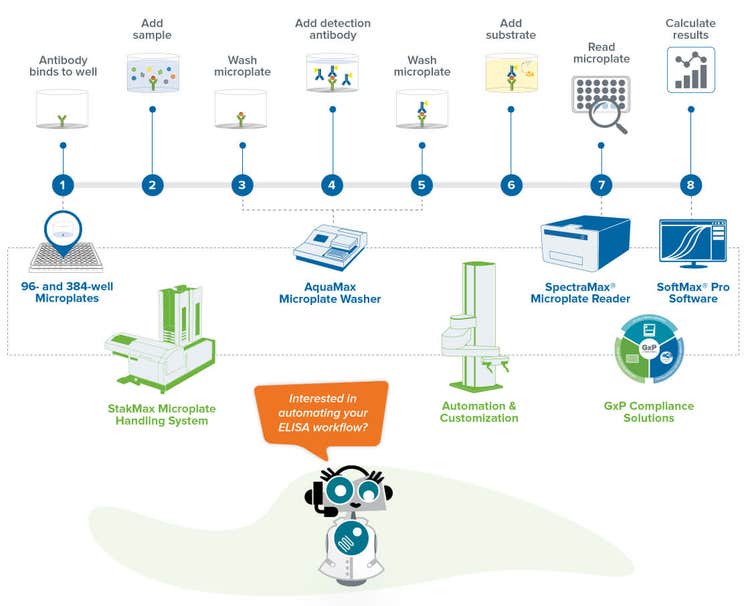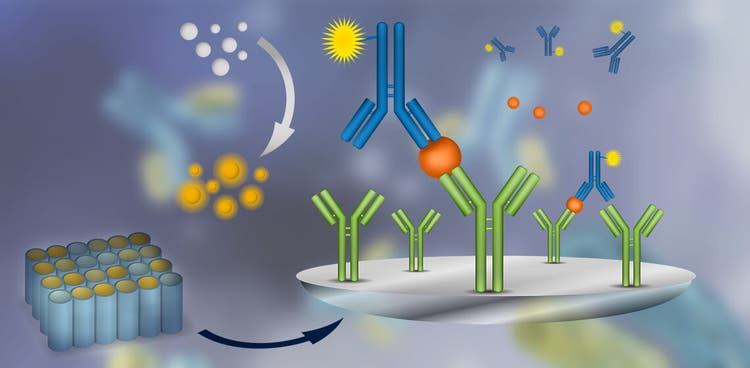What is ELISA?
ELISA (enzyme-linked immunosorbent assay) is a method used to quantitatively detect an antigen within a sample. An antigen is a toxin or other foreign substance, for example a flu virus or environmental contaminant, that causes the vertebrate immune system to mount a defensive response. The range of potential antigens is vast, so ELISAs are used in many areas of research and testing to detect and quantify antigens in a wide variety of sample types. Cell lysates, blood samples, food items, and more can be analyzed for specific substances of interest using ELISAs.
There are four major types of ELISAs: direct, indirect, competitive and sandwich. Each type is described below with a diagram illustrating how the analytes and antibodies are bonded and used.
Steps to run a sandwich ELISA assay
Most sandwich ELISAs are run in microplates, with the bottom of the plate wells serving as the solid surface to which antibodies and other reagents bind. A microplate washer is used to wash away non-specific material in the wells, and an absorbance ELISA microplate reader detects the color change produced when target antigen is present. And, a plate reader software is used to plot standard curves and calculate results.
The illustration below shows a workflow for a typical sandwich ELISA assay:

Step 1: Capture antibody binds to ELISA plate wells
Step 2: Add sample to well – antigen within the sample binds to the capture antibody.
Step 3: Wash microplate – Unbound material is washed away, leaving only the antigen of interest
Step 4: Add detection antibody – Enzyme-conjugated detection antibody binds to a second site on the antigen of interest
Step 5: Wash microplate – Unbound antibodies are washed away, leaving only those specific for the target of interest
Step 6: Add substrate – Substrate is converted by the enzyme on the detection antibody, producing a color change
Step 7: Read plate – The microplate reader detects the colored reaction product and outputs optical density (OD) values
Step 8: Calculate results – The amount of antigen in each sample is calculated and analyzed
While an ELISA is easy to set up, the assay procedure is time-consuming and labor-intensive. Laboratory automation for high-throughput plate-based assay workflows can help with providing walkaway time, increasing throughput, effectiveness and efficiency of the assay procedure, and reproducibility.
ELISA assays and applications
Enzyme-linked immunosorbent assay is a commonly used analytical technique performed in many research and biotech labs. Below is a collection of application notes, research and technology related to significant ELISA assays and applications.
Latest Resources
Workflow of an ELISA protocol
The workflow of a typical sandwich ELISA protocol has multiple reagent addition, incubation and wash steps. Here we’ve highlighted each step and the instrumentation and tools needed to conduct the ELISA assay including a microplate washer, absorbance ELISA plate reader and software.
Workflow: ELISA Assay Protocol

CAPTURE ANTIBODY BINDS TO WELLS
First, the capture antibody is bound to the bottom of the microplate well.

ELISA Plate
Most ELISAs are run in 96- or 384- well microplates, a 96-well plate being the most common and sometimes referred to as an ELISA plate. The bottom of the microplate wells serve as the solid surface to which antibodies and other reagents attach. Microplates are typically included in an ELISA kit.
Want faster ELISA results?
CatchPoint SimpleStep ELISA kits produce results in just 90-minutes!


ADD SAMPLE
Sample is added to the well, and antigen within the sample binds to the capture antibody.

WASH MICROPLATE
Unbound material is washed away, leaving only the antigen ofinterest and minimizing the potential for high backgroundsignal.
https://vids.moleculardevices.com/watch/db2tLDgnn3Bk9GpUSQ4VzQ
Microplate Washer
The MultiWash+™ Microplate Washer is a 96- and 384-well automated washer–compact, quiet, and efficient washer with 20 different wash protocol options.
Save on a bundle
Save time and money with a SpectraMax Microplate Reader, SoftMax Pro Software, and an AquaMax Microplate Washer bundle.


ADD DETECTION ANTIBODY
Enzyme-conjugated detection antibody binds to a second site on the antigen of interest, providing the means to detect the antigen.

WASH MICROPLATE
Unbound antibodies are washed away, leaving only those specific for the target of interest and again minimizing the potential for background signal.
https://vids.moleculardevices.com/watch/vGfoof4ysIDAd4XGwxqokQ
ELISA Plate Washer
The AquaMax Microplate Washer: Aspiration and dispensing of 96- and 384-wells occur simultaneously in all wells leading to high-precision assays and faster microplate processing without mechanical plate indexing or quadrant processing.

ADD SUBSTRATE
Substrate is converted by the enzyme on the detection antibody, producing a color change, with intensity proportional to the amount of antigen present.
Depending on the enzyme and substrate used, the readout can also be fluorescent or luminescent.

READ PLATE
The microplate reader detects the colored reaction product and outputs optical density (OD) values that indicate how much light is absorbed by the contents of each well.
https://vids.moleculardevices.com/watch/2tKEp18eNj6v1e31bfJwAe
ELISA Plate Reader
An ELISA plate reader, like the SpectraMax ABS Plus Absorbance ELISA Microplate Reader, detects the color change produced when target antigen is present. It does so by measuring how much of the light passed through the wells of the microplate is absorbed by the material within the wells. The more antigen is present, the higher the absorbance value.
https://vids.moleculardevices.com/watch/2tKEp18eNj6v1e31bfJwAe
ELISA Plate Reader Software
An ELISA plate reader software, like our SoftMax Pro data analysis software, is used to plot standard curves and calculate results from the absorbance values provided by the microplate reader.
A standard curve is run so that the amount of antigen in each sample can be accurately calculated. A preconfigured protocol, helps save time by calculating results automatically.

CALCULATE RESULTS
The amount of antigen in each sample is calculated, and different samples—for example, cells subjected to different treatment conditions—can be compared.
Automate your workflow
We offer scalable, automation-ready workcells ranging from entry-level to advanced, and can be customized to meet your specific research needs

https://vids.moleculardevices.com/watch/EsYUk5mwGne1KefZnMGZjq
Automation-ready ELISA workcells
Automating an ELISA workflow can take the tedious steps of sample prep, reagent pipetting, and microplate washing out of your hands and can improve the reproducibility of your results. An automated ELISA workflow can be paired with control software and components, creating scalable, high-throughput workcells.
